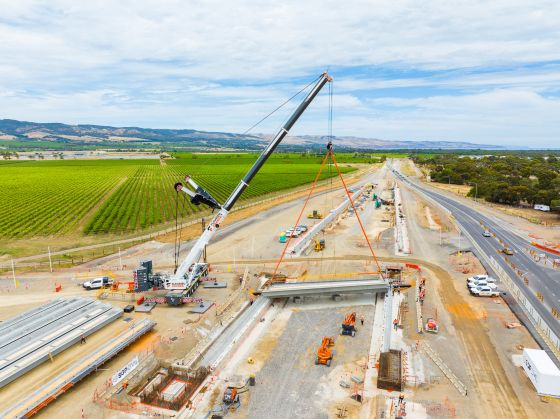Super big crane installs super-Ts for new Aldinga Bridge
Super big crane installs super-Ts for new Aldinga Bridge
One of the largest cranes in South Australia has lifted into place 12 super-T beams to support the new bridge at Aldinga - part of the new Aldinga Interchange, a key feature of the Main South Road stage 2 duplication project.
One of the largest cranes in South Australia has lifted into place 12 super-T beams to support the new bridge at Aldinga - part of the new Aldinga Interchange, a key feature of the Main South Road stage 2 duplication project.
The 700-tonne crane is approximately 45 metres tall, and this is the first time it has been used on a South Australian Government project. The super-Ts beams, each weighing 40 tonnes, were installed across two days, with some finishing work to follow.
The bridge deck will measure 26 metres long and 27 metres wide and will be supported by 53 concrete piles. The deck will be complemented by 62 architectural panels and 86 metres of anti-throw screens to enhance both safety and the visual appeal of the bridge.
The bridge underpass will be made up of 39,200 tonnes of asphalt to create 86,000 square metres of road pavement, with more than 15.5 linear kilometres of soil nails supporting the underpass walls.
Work on the bridge and interchange started in June this year. The Aldinga Interchange realigns the junctions of Aldinga Beach Road and Aldinga Road.
As well as the Aldinga Interchange, the stage 2 Main South Road duplication includes intersection upgrades at Hart and Colville roads, Norman and Rogers roads, Hahn and Cox roads and Sellicks Beach Road, plus installation of wide centre medians and wire rope barriers to improve safety by separating northbound and southbound traffic.
It also includes three U-turns to facilitate local access and a shared use path for pedestrians and cyclists along the western side of Main South Road, from Aldinga to Sellicks Beach.
Stage 2 of the Main South Road duplication between Aldinga Beach Road and Sellicks Beach is being delivered as part of the $810.4 million Fleurieu Connections project, funded by the South Australian and Australian governments.
The project is supporting 405 full-time equivalent jobs during construction.
The new bridge at Aldinga is expected to open to traffic in 2025, while the project is expected to be fully completed in 2026.
Contact:
Phone:
Email:
